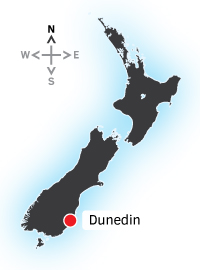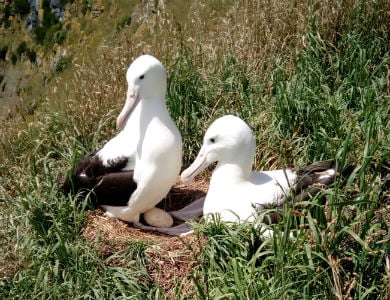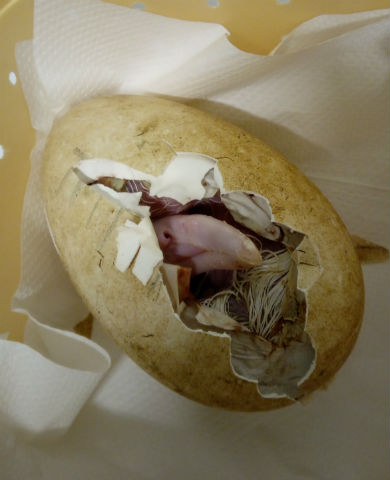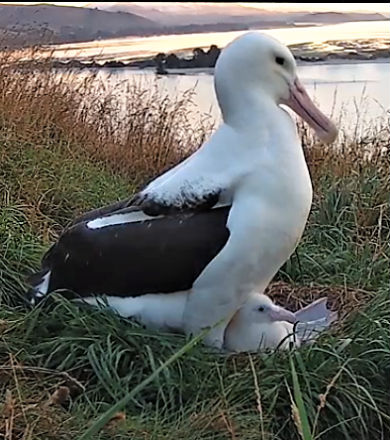What to expect on Royal Cam
Introduction
Read a month by month description of what is happening on camera and at the colony at Taiaroa Head.For more general information about the albatross colony and our work at Taiaroa Head, see our general FAQ page.
Video

Map of New Zealand, showing where the web cam is located
Read more detail about what is happening at the colony each month:
- September/October: Fledging and new nests
- November/December: Laying and incubating eggs
- January: Hatching chicks
- February: Post hatching and guard stage
- March/April: Feeding, play and curious juveniles
- May/June: Sex characteristics and adult feathers
- July/August: Banding and preparing to fledge
Watch the Royal Albatross short film to learn more about these birds and their life cycle.
September/October: Fledging and new nests
Fledging
When a chick is ready to go to sea, the wind direction, camera location and slope of the area will determine if we can capture this moment on Royal Cam. Some chicks walk to the lighthouse nearby to fledge during North-East winds, while others have been seen on Royal Cam.
Toroa chicks fledge during September, when they're around 7.5 months old, an average of 240 days (range 219 – 256 days). The oldest few chicks tend to depart before the younger ones, but it isn't all about age. Some chicks are at sites more exposed to favourable take off winds, so you might spot these chicks going to sea before older chicks of the same year. Once they've left, they are at sea for 4 - 10 years.
When the parents realise their chick has gone, they'll spend the following year building up their energy for the next breeding attempt. The great albatross species (wanderers and royals) breed every two years as it will have taken the two parents all their energy to raise the chick to fledging. This year's parents will not be in condition to breed again during this year.
New nests
What To Expect On The Royal Albatross Cam: September–October | Fledging And New Nests
During October, next season's adults arrive home after 12 months at sea, ready to start the new breeding cycle.
The territory is already established but they will choose a nest site in their territory and begin building a nest. For the egg to be fertile, mating needs to take place 2.5 weeks prior to egg laying.
The younger adolescents and returning juveniles turn up later in the year and early in the new year.
Once toroa arrive back, they stay to mate defend territory and build their nests. The male’s nest may be within 40 m of the nest he grew up in.
The birds that have partners will mate and stay until the chick fledges.
November/December: Laying and incubating eggs
Egg-laying
Egg-laying
Female Northern royal albatross lay one egg at a time. There is about a month between the first egg and the last egg laid in the colony.
DOC rangers then ‘candle’ each egg to record if it is fertile or infertile. Candling is the process of shining a specialised torch through the egg in a darkened space to check for blood vessels. Blood vessels indicate a fertile egg as these are for the developing embryo.
You can try this at home with a torch and a hen's egg in a dark room. They should not be fertile if bought for eating, so you won't see blood vessels, but you can see into the egg.
Incubating eggs

Parent changeover
Image: Sharyn Broni | DOC
Both parents take turns keeping the eggs warm. When parents swap for nest duties, you will see them communicate using specific behaviours. This includes yapping and preening each other. The bird preparing to leave will also pull grass.
Later, the parents start to take longer trips to feed at sea. Once the toroa start taking longer trips, they are usually at sea for 7–14 days. But if the mate at sea has not returned in this time, you will also see DOC rangers work to prevent the loss of the egg.
After 13 days, we replace the egg with a dummy egg. If possible, the real egg will be removed to another nest. But if no foster nests are available, we place them in the incubator. We will also consider supplementary feeding the adult on the nest at around 16–18 days.
If the missing bird does not to return, we remove the dummy egg to release the remaining partner.
January: Hatching
After laying their eggs in November, the parents continue to share incubation duties during January and February. Parents take turns to keep the egg warm from two days to three weeks at a time, spending an average of eight days each in the nest.
Although before the egg is laid and prior to hatching, they will swap sooner. They will continue to do this throughout the entire incubation period of about 11 weeks (79 days, range 76 – 82). Northern Royal Albatross incubation is one of the longest of any bird.
Once the egg begins to hatch, rangers remove it and incubate it. They then turn the hatched chick to the nest, after which you will see them regularly weighing the chick and checking its health.

Albatross chick hatching
Image: Sharyn Broni | DOC
Hatching
Eggs start to hatch around mid to late January, or the start of February. This is the busiest time for DOC rangers, as flies are a major problem at the hatching stage when the weather is hot and the wind calm.
Why we incubate hatching eggs
After making a hole or pip in the tough shell, chicks take about three to six days to fully emerge. During this time, flies can lay maggots on the egg or the young chick (‘fly strike’), which can quickly lead to their death. Flies have been one of the biggest causes of chick deaths at Pukekura/Taiaroa Head.
To help prevent this, we spray nests with insect repellent that has been specially formulated to be safe for the birds. We spray the nest when pipped eggs are moved to the incubator, and again when the hatched chick returns to the nest. While the hatching egg is in the incubator the parents incubate a dummy egg.
February: Guard stage
Post-hatch guard stage
Guard stage chicks

Albatross and chick at guard stage
Image: Royal Cam | DOC and Cornell University
Parents constantly guard their chicks once they have started hatching until they are 21 – 40 days old. Taking turns to feed or guard the chick during this time.
From around 3 weeks old the chick will be getting too big to fit under the adult and you will see it staying close to the nest. At this stage it can retain more body heat so does not need constant brooding from a parent. The chick can move out of the nest but rarely will until it is 3 months old because if a parent arrives and they cannot find it, it will not be fed.
When first breaking out of the egg, the yolk sac will keep chicks going. Sometimes chicks will not get their first meal until they are two days old. Then they will start to be fed regurgitated food by a parent a few times a day. The amount each chick gets given in the first few days or weeks can vary from 10 g to 100 g per meal.
The adults have enough food for more than one feed while the chick is small, but as the chick grows food can become scarcer. So, they are fed once before the adult heads back to sea.
March/April: More feedings, play and curious juveniles
At six weeks, the chick is much larger and you'll start to see the parents leave the nest unguarded to find food. This is known as the 'post-guard stage'.
Watch what to expect on Royal Cam in the post-guard stage
More feedings
When the chick is 4-6 weeks old, both parents are on full-time food gathering duties. From April, the adults will come to feed the chick and leave within 10 minutes.
Once parents leave the chick alone for the first time, it may only be for part of the day. As the chick is left alone more regularly, it can become 2-3 days before next parent and meal arrives. It is normal for the chick to be by itself overnight. Its stomach can hold enough food to last days, then up to a week as it grows.
If a chick goes too long time without a visit from a parent or is underweight, you may see rangers feed it with a well-blended fish smoothie to avoid lumps that could get caught. This is because adult albatross will only feed their own chick at this stage and will not foster another. So, if a chick’s weight is significantly low for its age, DOC rangers will feed it.
Play nests and curious juveniles
You will not see the chick move far from its nest as its legs are not strong yet. But often you will see chicks make 'play nests' close to their hatch nest where they may stay for lengthy periods. As it grows, it will wander and perhaps off camera, but never too far.
You might also see curious juvenile birds investigate the chicks. They usually will not cause any harm but may make the chick anxious, which can cause them to vomit fish oil to protect themselves. It is best this does not happen, as the down becomes less waterproof compromising the chick’s health for winter. However, you will not see us shooing them, as we do not want the chick or parents to become fearful of us or the nest while we support them.
May/June: Sex characteristics and adult feathers
As the chick grow to one hundred days old, you'll see their sex characteristics. This includes weight, profile, and temperament changes.
Males are heavier and larger than females and tend to be more aggressive. We use these changes to predict the sex of the chick, but now use less invasive DNA analysis of blood cells taken from the hatched egg. The process takes a couple of weeks after the last chick has hatched.
The chick will also start to lose its fluffy down from the end of its adult feathers. You will see the chicks starting to look more grown-up.
July/August: Banding and preparing to fledge
What to expect on Royal Cam in July and August.
Banding
You will see us band the chicks in either July or August, when their legs are near their adult size and there is still a month before they depart. Chicks whose nests are close together and when they move around need to identify be identified accurately.
Chicks get an individually numbered stainless-steel band on their left leg and, some years, a coloured plastic band on their right leg. These bands fit around the leg and is a bit like wearing a loose watch for the bird. The coloured band has two purposes:
- Quick identification for staff prior to the bird’s departure – the coloured band has a large number engraved on it, making it easier to see who that bird is.
- The bird will spend the next 4–10 years at sea, during this time they are referred to as juveniles. On returning and prior to breeding they are known as adolescents. Occasionally, an adolescent returns having lost the stainless-steel band, so the coloured band helps identify those birds.
Preparing to fledge
You'll see the chicks exercise their wings before they depart. They'll start flapping on ground or holding their wings out facing the wind. This is their first stage of building up muscle strength in their wings. As the chicks become lighter in preparation to fledge, you'll see some brief practice flights, where they'll hovering above the ground in the colony. This helps them learn how to take off and land.
During this time, the chicks become more active, moving to other parts of the headland to make use of winds from all directions to practice the skills needed for fledging. Sometimes their hovering will turn into more of a practice flight, and the bird will travel many metres. However, their first actual flight will be as they fledge without returning to the headland after 4 to 10 years.
Northern Royal Albatross do not have a gap between each breeding season like many other species. Those parents that do successfully raise a chick spend a year away feeding up for the breeding season in 12 months’ time and the other half of the breeders who have been away for the previous 12 months will breed in the new season coming up.
